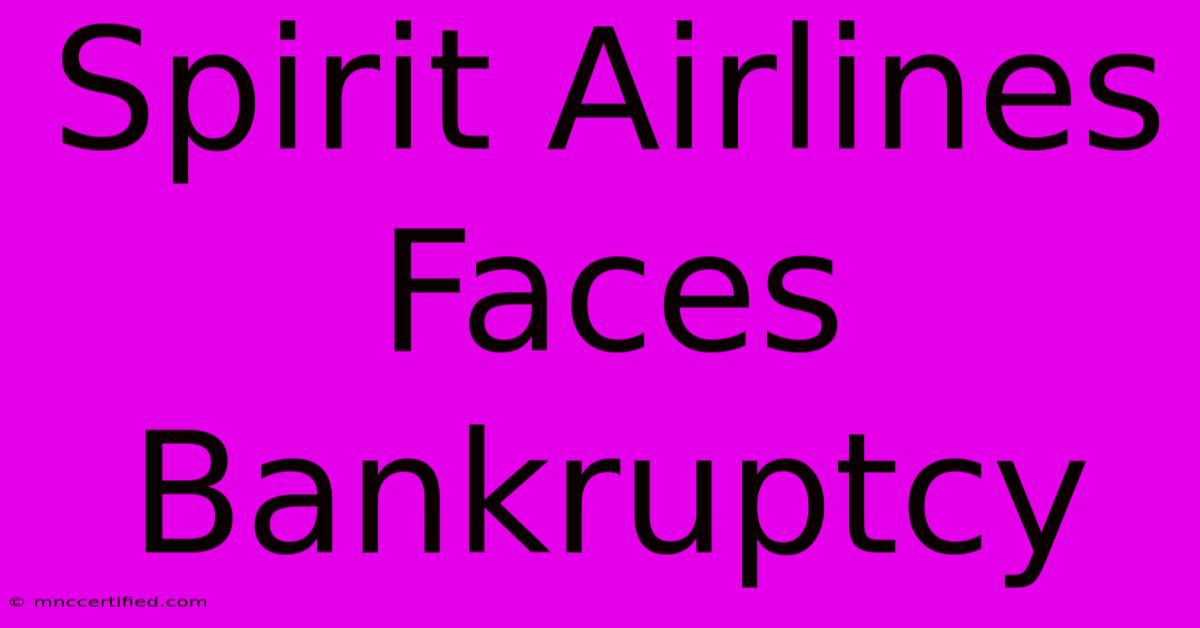Spirit Airlines Faces Bankruptcy

Table of Contents
Spirit Airlines Faces Bankruptcy: A Deep Dive into the Challenges and Future Outlook
The possibility of Spirit Airlines filing for bankruptcy has sent ripples through the travel industry. While the airline hasn't declared bankruptcy yet, persistent financial struggles and operational challenges have fueled considerable speculation and concern among investors, employees, and passengers alike. This article will delve into the factors contributing to Spirit's precarious financial position, examining the potential consequences and exploring the airline's prospects for survival.
The Perfect Storm: Factors Contributing to Spirit's Financial Distress
Several interconnected factors have converged to create a challenging environment for Spirit Airlines, pushing it towards the brink of bankruptcy.
1. Rising Fuel Costs and Inflation:
The airline industry is heavily reliant on fuel, and the recent surge in fuel prices has significantly impacted Spirit's operating costs. Coupled with broader inflationary pressures affecting maintenance, staffing, and other operational expenses, Spirit's profitability has been severely squeezed. Fuel hedging strategies, while sometimes effective, haven't been enough to offset the unprecedented price volatility.
2. Intense Competition:
Spirit operates in a highly competitive market. The rise of low-cost carriers (LCCs) and the aggressive pricing strategies of established airlines have intensified the battle for market share. Spirit's ultra-low-cost model, while attractive to budget travelers, can make it difficult to compete on amenities and overall customer experience, impacting customer loyalty. Competitive pressures have forced the airline to maintain razor-thin margins, leaving little room for error.
3. Operational Inefficiencies and Labor Relations:
Reports of operational inefficiencies and challenges in labor relations have also contributed to Spirit's struggles. Pilot and flight attendant shortages, alongside logistical issues, have led to flight cancellations and delays, damaging the airline's reputation and impacting customer satisfaction. These operational hiccups translate into increased costs and lost revenue.
4. Debt Burden and Financial Leverage:
Spirit Airlines carries a significant debt burden, further exacerbating its financial vulnerabilities. High levels of debt increase the airline's financial risk and limit its flexibility in responding to unforeseen challenges like the current economic downturn. Managing debt effectively is crucial for Spirit's survival, but the current economic climate makes this exceedingly difficult.
Potential Consequences of Bankruptcy:
If Spirit Airlines were to file for bankruptcy, the consequences would be far-reaching:
- Job losses: Thousands of employees could face job losses.
- Disruption to travel plans: Passengers with existing bookings could experience significant disruptions.
- Impact on the broader aviation industry: The bankruptcy of a major LCC could trigger further consolidation and instability within the sector.
- Loss of investor confidence: The event could negatively impact investor sentiment towards the airline industry as a whole.
Spirit's Path Forward: A Fight for Survival?
Spirit Airlines is actively trying to navigate these challenges. Restructuring operations, renegotiating contracts, and exploring cost-cutting measures are all potential strategies. However, the success of these efforts remains uncertain, given the severity of the headwinds the airline is facing. Strategic partnerships or a potential acquisition could also offer a lifeline. Ultimately, Spirit's future hinges on its ability to adapt to a rapidly changing market and regain its financial footing.
Conclusion: An Uncertain Future
The future of Spirit Airlines remains uncertain. While the airline hasn't filed for bankruptcy yet, its financial struggles are undeniable. The combination of rising fuel costs, intense competition, operational challenges, and a significant debt burden presents a formidable hurdle. Only time will tell if Spirit can successfully navigate these obstacles and avoid the fate of bankruptcy. Careful monitoring of the airline's financial performance and strategic decisions is crucial for stakeholders and passengers alike. The next few months will be critical in determining the airline's ultimate fate.
Keywords: Spirit Airlines, bankruptcy, airline industry, low-cost carriers, financial distress, fuel costs, competition, operational inefficiencies, debt, restructuring, acquisition, travel industry, aviation, flight cancellations, economic downturn, investor confidence, labor relations, fuel hedging, competitive pressures, managing debt.

Thank you for visiting our website wich cover about Spirit Airlines Faces Bankruptcy. We hope the information provided has been useful to you. Feel free to contact us if you have any questions or need further assistance. See you next time and dont miss to bookmark.
Featured Posts
-
Dune Prophecy Episode Release Dates
Nov 19, 2024
-
Multiple Sclerosis Life Insurance
Nov 19, 2024
-
Bernard On Holding Kelce Low Game
Nov 19, 2024
-
Highlights Croatia Vs Portugal Nations League
Nov 19, 2024
-
Swimming Pool Liability Insurance
Nov 19, 2024